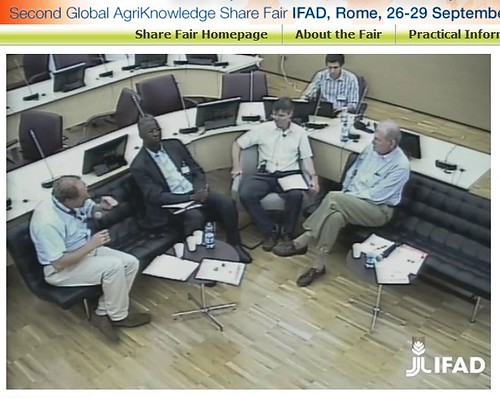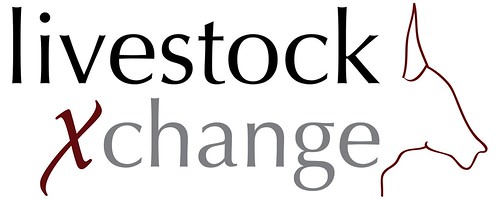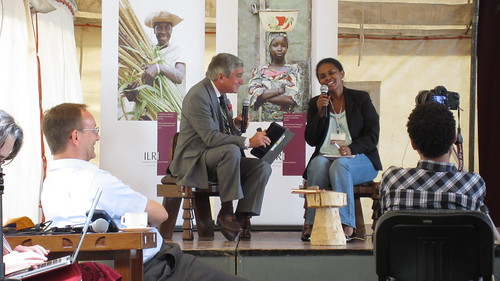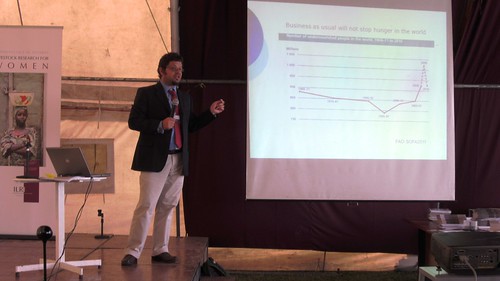 On Tuesday 27 September, the AgriKnowledge Share Fair session on ‘Livestock Research for Development: Shifting the Paradigm’ brought together ILRI Director General Carlos Seré, FAO Assistant Director General Modibo Traoré, and IFAD Senior Technical Advisor on Livestock and Farming Systems Antonio Rota to discuss major changes, innovations and achievements in livestock research for development in the last 5-10 years.
On Tuesday 27 September, the AgriKnowledge Share Fair session on ‘Livestock Research for Development: Shifting the Paradigm’ brought together ILRI Director General Carlos Seré, FAO Assistant Director General Modibo Traoré, and IFAD Senior Technical Advisor on Livestock and Farming Systems Antonio Rota to discuss major changes, innovations and achievements in livestock research for development in the last 5-10 years.
The aim of ther session was to ‘tease out’ their views on 1) the major changes, innovations and achievements in livestock research for development – in the last 5-10 years; and 2) upcoming challenges and opportunities for sustainable livestock sector development, especially of smallholder livestock keepers.
What’s changing?
Responding to the question ‘What’s changing in the livestock sector’, Traoré answered “everything!” – but the most challenges face the smallest and poorest farmers – they are struggling to adapt to changes, to make money, and to benefit from positive trends – such as growing demands for livestock products.
Smallholder focus?
How we ensure that we grasp the opportunities offered by these growing demands is controversial, according to Seré. Should we invest in smallholders or go for large scale more commercial operations?
He argued that smallholders particularly depend much more on communal action and public sector support so we need to decide Where public knowledge will make the most difference for smallholders. Where do we have the best chances to bring people out of poverty through livestock? What will happen to the small livestock keepers when the market changes? Will they disappear?
According to Seré, the future in some areas is a transition [from small to large scale]; in others, smallholder ssytems are more sustainable. Indeed, smallholder livestock “can be very competitive” in some areas or situations.
Rota continued the focus on ‘smallness’ arguing that small livestock are ‘the’ livestock of the poorest. He said that the ere of ‘blanket solutions’ for livestock is over: We have to design projects responding to real needs, projects thast much better target specific needs, services, markets and people.
Traoré concurred that the focus of public investment in livestock development should be on small farming systems, but he cautioned that smallholders and small-scale farming don’t just need small animals; a cow is as much an asset as smaller sheep or goats.
Roles for research?
Seré suggested that livestock research as we know it struggles to meet the smallest scale. Nevertheless, we’ need to keep the focus of our investments on small farmers … as nobody else is interested in them.
A major challenge is to bring research much closer to the clients. Innovation systems that bring in many different actors, also farmers, are important to help us connect to communities.
We still need technologies, but if we want them to make a difference we need to expand what research does, encompassing institutional issues, knowledge, and capacities. For development impact, research needs to be much more than just technologies, vaccines and the like.
Rota further argued that the livestock chosen for research are also important. As a development agency, IFAD helps to catalyze research around promising ‘orphan’ animals (from a developemnt research perspective) – like poultry, camels, or guinea pigs – that offer much to smallholders but which are hardly researched and supported.
A major weakness in our approach, accoridng to Seré is that we have not been able to scale out promising livestock research results. It seems to be much more difficult and complex to design and scale livestock interventions than it is for crops. Innovation systems thinking is again important here as it helps us gain a better understanding of the whole picture.
For Traoré, what is wrong in our approach is not that we have been unable to make many improvements … the problem is that some people see small farming systems as a transition phase only, not something where improvements should be scaled and continued. In his view, small-scale systems will remain and will continue to provide livelihoods for millions of people.
Questions and answers
The panelists reacted to questions from the audience, including:
- What’s the key factor determining the adoption of livestock technologies? Seré explained that research often does have the solutions and the technologies, but at different times, and for moving targets. If the incentives are right, technologies will get adopted. There is also a good reason why some technologies are [still] on the shelf … they will be needed in the future! Rota added that technologies will be adopted when we put more money in the pockets of the farmers.
- Why is the livestock sector not better-funded? Is it because the image of livestock in developed countries is rather negative (methane emissins etc) – and how do we counter this? Traoré commented that the image of livestock in the north is not the same as livestock in the south. We need to convert northern views to see that livestock [in the south] are goods whose development needs to be supported. This is a communication problem that we all need to work on. Rota further argued that if we want the donors to fund livestock, then we need to have and to present convincing numbers, data and evidencee that show how livestock really do bring people out of poverty. At this time, “we dont have the data” we need.
- Livestock on farms are integrated, how do we ensure that crops and livestock are integrated in development projects and in research? According to Seré: we need to make sure that assessments of crops (returns, beenfits etc) also take account of the livestock dimensions.
- How do farmers get the best advice and information, for instance on the ‘right’ types of cows for their situations? Seré emphasized the important commercial drivers determining what cows (or other technologies) are provided to farmers; it is thus difficult to provide quick clear-cut answers to this question.
View the webcast:
 On 9 and 10 November 2011, the International Livestock Research Institute (ILRI) Board of Trustees hosted a 2-day ‘liveSTOCK Exchange’ in Addis Ababa to discuss and reflect on livestock research for development. It was designed to contribute to the development of ILRI’s strategy in 2012 (see the current strategy). The event brought together about 130 participants from ILRI as well as from research and development partners.
On 9 and 10 November 2011, the International Livestock Research Institute (ILRI) Board of Trustees hosted a 2-day ‘liveSTOCK Exchange’ in Addis Ababa to discuss and reflect on livestock research for development. It was designed to contribute to the development of ILRI’s strategy in 2012 (see the current strategy). The event brought together about 130 participants from ILRI as well as from research and development partners. Between the sessions, we organized three ‘hard seat’ interviews; read – and see – them here:
Between the sessions, we organized three ‘hard seat’ interviews; read – and see – them here:


